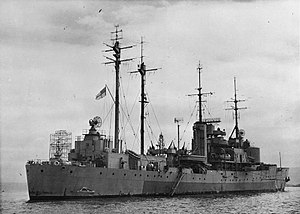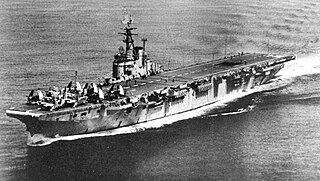
HMCS Magnificent was a Majestic-class light aircraft carrier that served the Royal Canadian Navy from 1948–1957. Initially ordered by the Royal Navy during World War II, the Royal Canadian Navy acquired the Magnificent while waiting for another aircraft carrier to be completed to their needs and it entered service in 1948 replacing in service HMCS Warrior which had been loaned for two years by the RN.

HMS Eagle was an Audacious-class aircraft carrier of the Royal Navy, in service 1951–1972. Until the arrival of the Queen Elizabeth-class aircraft carriers in the 21st century, she and her sister Ark Royal were the two largest Royal Navy aircraft carriers ever built.

HMSM33 is an M29-class monitor of the Royal Navy built in 1915. She saw active service in the Mediterranean during the First World War and in Russia during the Allied Intervention in 1919. She was used subsequently as a mine-laying training ship, fuelling hulk, boom defence workshop and floating office, being renamed HMS Minerva and Hulk C23 during her long life. She passed to Hampshire County Council in the 1980s and was then handed over to the National Museum of the Royal Navy in 2014. A programme of conservation was undertaken to enable her to be opened to the public. HMS M33 is located within Portsmouth Historic Dockyard and opened to visitors on 7 August 2015 following a service of dedication. She is one of only three surviving Royal Navy warships of the First World War and the only surviving Allied ship from the Gallipoli Campaign, the other being the Ottoman minelayer Nusret, preserved in Çanakkale.
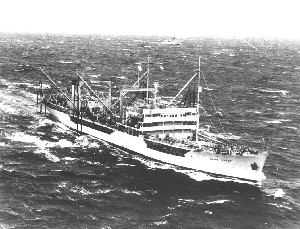
RFA Wave Chief was a Wave-class fleet support tanker of the Royal Fleet Auxiliary that was built in 1946 as SS Empire Edgehil by Harland & Wolff, Govan, Glasgow, United Kingdom.

Landing craft are small and medium seagoing watercraft, such as boats and barges, used to convey a landing force from the sea to the shore during an amphibious assault. The term excludes landing ships, which are larger. Production of landing craft peaked during World War II, with a significant number of different designs produced in large quantities by the United Kingdom and United States.

Landing Ship, Tank (LST), or tank landing ship, is the naval designation for ships first developed during World War II (1939–1945) to support amphibious operations by carrying tanks, vehicles, cargo, and landing troops directly onto shore with no docks or piers. This enabled amphibious assaults on almost any beach.

HMS Unicorn was an aircraft repair ship and light aircraft carrier built for the Royal Navy in the late 1930s. She was completed during World War II and provided air cover over the amphibious landing at Salerno, Italy, in September 1943. The ship was transferred to the Eastern Fleet in the Indian Ocean at the end of the year. Unicorn supported the aircraft carriers of the fleet on their operations until the British Pacific Fleet (BPF) was formed in November 1944. She was transferred to Australia in early 1945 to support the BPF's operations during Operation Iceberg, the Allied invasion of Okinawa in May. To shorten the time required to replenish the BPF's carriers, the ship was based in the Admiralty Islands and in the Philippine Islands until the Japanese surrender in August. Unicorn was decommissioned and placed in reserve when she returned to the UK in January 1946.

HMS Rifleman was a turbine-powered Algerine-class minesweeper of the Royal Navy. She was launched in 1943 and saw active service during World War II, both in the European and Far East theatres. After the war she served in the Mediterranean and was used as an accommodation ship in Barrow before being sold for breaking in 1972.
HMS Start Bay (K604/F604) was a Bay-class anti-aircraft frigate of the British Royal Navy, named for Start Bay in Devon. In commission from 1945 to 1946 in the Mediterranean Fleet, she spent most of her career in the Reserve Fleet.

HMS Widemouth Bay was a Bay-class anti-aircraft frigate of the Royal Navy, named for Widemouth Bay in Cornwall.

HMS Tyrian was a S-class destroyer built for the Royal Navy during the Second World War.
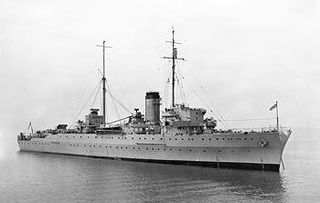
HMS Protector was an Antarctic patrol vessel of the Royal Navy between 1955 and 1968. She was built in 1935 as a net laying ship.

An amphibious warfare ship is an amphibious vehicle warship employed to land and support ground forces, such as marines, on enemy territory during an amphibious assault.
Empire Cedric was the first ro-ro ferry. She was built for the Royal Navy as the Landing Ship, Tank, HMS LST 3534. She was commissioned in 1945 and converted for civilian use as a ferry in 1948. She was used in the Irish Sea on routes between Preston and Larne, and Preston and Belfast. In 1956, she was requisitioned by the Royal Navy for a few months during the Suez Crisis as HMS Empire Cedric. She served until 1960 when she was scrapped.
Empire Curlew was a 4,273 GRT ferry that was built in 1945 as LST Mk.3 HMS LST 3042 by Harland & Wolff, Govan, Scotland for the Royal Navy. In 1947, she was renamed HMS Hunter. During the Suez Crisis in 1956, she was transferred to the Ministry of Transport and renamed Empire Curlew. She served until 1962, when she was scrapped.
Empire Cymric was a 4,820 GRT Ferry that was built in 1944 by Harland & Wolff Ltd, Belfast as LST (3) HMS LST 3010 for the Royal Navy. She was transferred to the Koninklijke Marine in 1945, serving as HNLMS LST 3010. In 1947, she was transferred back to the Royal Navy and renamed HMS Attacker. The ship was requisitioned by the Ministry of Transport in 1954 and renamed Empire Cymric. Requisitioned briefly during the Suez Crisis in 1956 as HMS Empire Cymric, she served until 1962, and was scrapped in 1963.
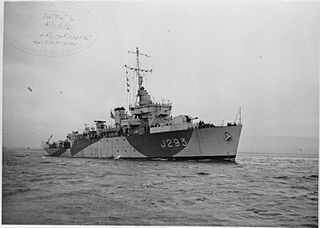
HMCyS Parakrama, was a turbine-powered Algerine-class minesweeper of the Royal Ceylon Navy, originally built as HMS Pickle (J293) for the Royal Navy during World War II, and transferred to Ceylon by the United Kingdom in 1958. She was scrapped in 1964.
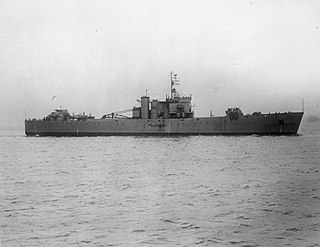
HMS Bruiser was built as a Landing Ship, Tank at Harland and Wolff. Launched in October 1942 and commissioned the following March, she saw service as part of the Allied invasion of Italy.
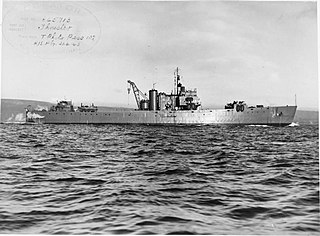
HMS Thruster (F131) was a Mark I LST built by Harland and Wolff. Launched in September 1942 and commissioned the following March, she saw service as part of the Allied invasion of Italy.

HMS Cheerful (J388) was a turbine engine-powered Algerine-class minesweeper during the Second World War.
